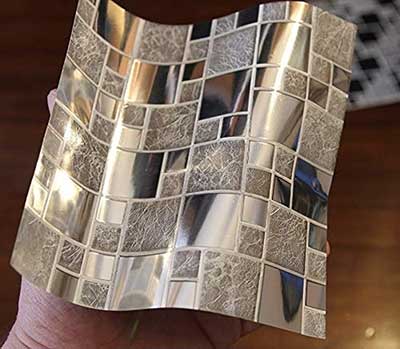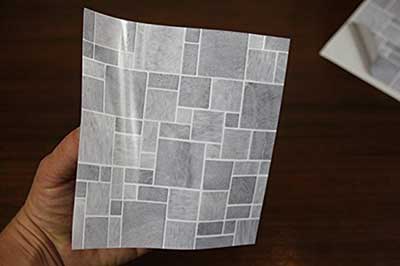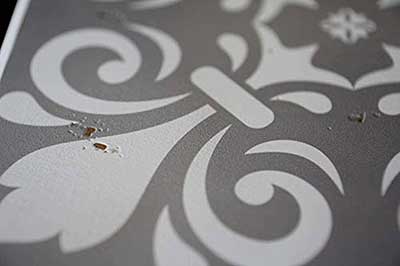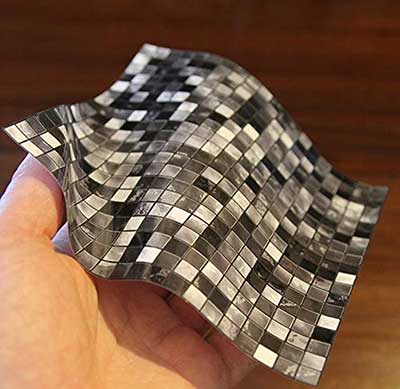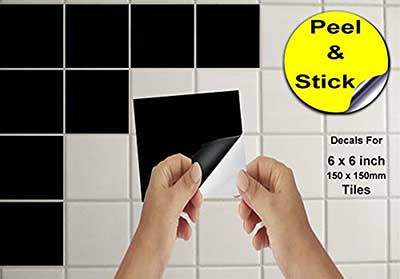Wouldn’t it be nice if…
In this day of push-button technology and instant results, how come it never seems to work quite like that when it comes to doing some little job around the home? All I want is to change the look of the kitchen somehow. You would think that like many problems it would be a case of just throwing some money at it and all will be delivered without any problem whatsoever. It’s not quite as simple as that I’m afraid.
If you look for the best quality tile stickers then I have a few suggestions, you can get them from Amazon, yes, I have been using these and that is how I know that the tile transfers listed below are fine quality but for sensible money:
Deciding what you want
To be honest, I’m not quite sure of what I want. So that will mean doing some research. This urge to change started when I was reading a magazine and noticed photo of a kitchen in there that I liked. Flipping through more magazines might be a place to start. I could also look online to see what the latest kitchen fashions are. Did you realize there are kitchen fashions? I didn’t until I saw a few before and after photos and articles talking about how fashions change. Who knew?
Click here for – Grey Tile Stickers
Shopping time?
Both my husband and I work during the week, so can only go looking around the homemaker showrooms at weekends. Even then, it will be a bit of a rush because there are many other things we also have to fit into our weekends and that’s provided one of us is not on the Saturday Rota for going into work. This also means we are not going to have much time to do any kitchen makeover ourselves.
Click Here for – Mix Designs Tile Stickers for 6 inch Tile
Hidden expenses
It occurred to me that if we get someone in to do any work for us, that will also mean one of us has to try to get some time off work to be home while we have workmen in. So not only do we have to pay the workmen, we also get pay docked for having time off. There’s a substantial hidden expense for you. I just know that my husband won’t want to have time off if it’s my project and it involves remodeling.
Click here for – Black White Tile Stickers
The scope of the project
As I’m not planning on replacing all my kitchen units, the cupboards and drawers, nor do I need a new hob or oven, that basically leaves the walls and the paintwork needing attention. Actually, the walls are mostly painted, so all I need to do there is to clear all my notes and bric-a-brac off them, give them a good wash down with sugar soap, and repaint them.
Doing or delegating
Same with the woodwork, door frames and the like. A good wash down, a light sanding over to make sure the new paint keys properly and they’ll be good as done. Once I’ve decided on a color scheme I can do that kind of job myself in the evenings or a weekend. Might even be lucky enough to delegate some of the work to my husband. Wonder if I could sell it to him as ‘sharing’ or togetherness? Lol
Click here for – Black Tile Transfers
Are there limitations?
That leaves the floor and just one other area to be updated. The tiled splashbacks behind the hob and counter tops. The floor is tiled too. Replacing those tiles would be an absolute nightmare, so they can stay. I have laid vinyl covering over floor tiles before and, to be honest, it was not a great success for me. I might add a scatter rug or something on it. Something easy to lift and shake clean. I’ll look at that again later when the rest is done and I’ve got a better idea of a color and style that would suit the rest of the room.
Experience can help
In the last house we had, I did have to have the kitchen completely remodeled as it was in a pretty poor state when we got the place. That included replacing the splashback tiling. So I know what needs to be done with that is quite a messy job and not as simple as you might think.
What a mess!
The whole area needs to be completely cleared and covered with dustsheets. The reason for this is not just to catch the dust and the debris. Broken ceramic tile pieces are as sharp as shards of glass and can do as much damage in the way of cutting and scratching whatever they hit when there is someone using a hammer and chisel to break them away from the wall. The dust sheets are extra protection for counter tops and other fixtures and fittings from the sharp edges that will be flying about.
Extended preparation time
Once the wall has been cleared of the old unwanted tiles, it quite often needs a skim of sand and cement or plaster of some sort to make the surface even again. New tiles have to have a reasonably flat surface to be fixed to. This is usually an overnight wait for the new skimming to set properly before applying new tile cement the next day. See how the job has just got longer? Another day off work.
Which tiles?
Looking at the price of new tiles can be totally bewildering. Different sizes, makes, ranges, colors, styles, and lots of other criteria. Depends on the manufacturer too – are they from a big name in tiles, a smaller company with a special offer or a make-a lot-sell-them-cheap company that deals with discount outlets?
Feature tiles
In the original magazine photo, I saw there were some ‘feature tiles’ set in among the plain tiles. A creative feature I quite liked. Until I saw that many of these ‘feature’ tiles were several times the price of the standard tiles around them. No wonder there was only two or three feature tiles shown.
The total cost
Asking around I am given a rough idea of what a labor rate would be for a skilled tile fitter to come and do the job. Bit of a guess I know, as I haven’t asked directly for a quote. I just said what the size of the area that needs retiling is and the area I live in. To that price I added the cost of the tiles I liked. I then added what I’d forfeit in the way of two days pay.
Now I’m not going to say an exact price here, because if you do the same exercise you are sure to come up with a different figure. However, I do know that whatever price you get, it will not exactly be peanuts. The other factor is, “Do I really want someone in my house making all that mess and dust that will permeate through the whole kitchen, inside the cupboards and everywhere, taking me weeks to go through everything to clean it all out again.” Probably not.
The viable alternative
Fortunately, one of the technologies that has progressed in leaps and bounds over the last few years means I don’t have to do any tile changing at all. As this is a site about wall tile stickers, you will probably guess that’s what I’m talking about. Where I don’t have to have someone in, at great expense, and all the mess they would create. It’s something I can do myself and, provided I take the appropriate care, will look every bit as good as replacement ceramic tiles.
The change I wanted – and I get to show off.
The more I think about doing the job myself using wall tile stickers the more it appeals to me. I can change all the tiles to make a complete color change or just add a few feature tile stickers to create enough of a difference. I can do both of course. Because there is now so many tiles stickers to choose from, choosing which ones will be my only problem.
Apart from not having to get someone in to do the tiling for me, I don’t even have to ask my husband if he’ll do it either. With just the minimum of tools I can do it all myself. Think of what an achievement that will feel like. I’ll have to take care doing it of course.
So How Has Tile Sticker Technology Changed?
3 Technology changes
Although wall tile stickers may only look like printed bit of paper or vinyl, there are actually three major technologies involved in their manufacturing process that have changed enormously over the last few years. They are the adhesives used to hold them to the surface you stick them on, as I’ve said earlier that’s not always walls. The way they are printed and the finishes added after printing.
Adhesives that stick
If I started telling you all about how the adhesives of today are so different from those of even just 10 years ago, two things would happen. I’d go straight out of my depth, because I know virtually nothing of how polymer based adhesives work, and you would get instantly bored. So let’s just say that, provided they are applied as per instructions, clean surfaces and all that, they work fantastically well. So much better than the one-glue-does-everything adhesives of the past.
Printing a fortune
Until digital printing evolved the only way to print anything was to make a series of very expensive printing plates to put in a press that would then have to run thousands of identical copies off to make the cost of those plates a commercially viable exercise. Color printing on a press is made up from four to six base colors, each base color needing its own plate. As you might imagine, setting a press up to run off a single tile would be prohibitively expensive.
Printing by numbers
Enter the digital press. No plates are involved. The digital press can print what it sees on a digital image. This means that if twenty different tile patterns were required, and a different number of tiles for each pattern, then that is exactly what a digital press will print in a matter of a minute or so. No set up’s other than to put the twenty patterns and the quantities required on to its internal computer. That is why it’s now so cheap to produce printed items for many different applications, not just tile making. The biggest expense is the cost of a digital printer, not the ancillary equipment to run it.
Finishing touches
For a sticky-backed wall tile in either a kitchen or a bathroom, we need them to be made so they keep looking good for quite some time. This is the job of the different finishes that are applied to the basic printing of a tile. The various coats of invisible finishes make tiles so they are waterproof, essential for bath and shower rooms. Oil resistant, anything that splashes on to them in a kitchen can easily be wiped off. Heat resistant. Heat resistant does NOT mean fireproof. Most pliable materials will change form if a direct flame is applied.
To qualify to be called heat resistant means they will retain their shape and color and not peel off the wall, or whatever they are stuck on, if a reasonable heat source is near to them but not aimed directly at them. Reasonable heat sources for tile stickers being a cooker hob or hot showers. Being stuck on a front facing surface of a fireplace is generally ok, but not on the faces that are angled towards an open fire, as some ceramic tiles are. A good guide is that if you can put your hand on a surface and it does not become uncomfortably warm within a minute, it is usually suitable for putting a tile sticker on to.
All change
If, after a period of time, you really do want to remove tile stickers, the best way is to apply a gentle heat source to them to soften the adhesive backing and they will easily peel off once you have it sufficiently warmed. The safest and best heat source for this would be a hair dryer set to hot. Play the hairdryer over the tile you want to remove and just peel it off from one corner. If any adhesive sticks to surface below the tile, try rubbing the area with nail varnish remover (acetone), it should come off easily.
Easy updates and restoration
Personally, I can only think of two reasons you would want to remove your tile stickers. One is to replace them with a new and different design or color. Keeping up with the latest styles. The other is if you are in a rented property and about to move on. Landlords often want their property put back to how it was when you first moved in, regardless of if what you have done is an improvement or not. This makes tile stickers ideal for rental properties where you want to add a touch of decoration to make it feel more individual and your own home.
Installation basics
Several times I’ve said wall tile stickers must be applied correctly. There are five basic rules as to what applied correctly means. 1, The surface the tile stickers are to be applied to must be clean. 2, The surface the tile stickers are to be applied to must be flat. 3, There must be no air bubbles under the tile stickers once applied. 4, The surface the tile stickers are to be applied to must not be constantly warm or hot. 5, Tiles stickers are not hard-wearing enough to be suitable for use on floors.
Clean
The adhesive will stick to virtually anything it touches. It even sticks to grease. Unfortunately, it’s the grease that is not fixed and does not have a firm base. It’s very slippery in fact, as it should be. So when a tile sticker doesn’t stick straight away, it’s almost always due to the fact the surface has not been cleaned thoroughly. I go into in some depth about how to clean and prepare the area elsewhere on this site. No point in repeating it all again here. However, I show you here a short video created by my friend.
Flat
The reason it must be flat is because there must be no air beneath the tile once it’s in place. If you do try to place it on an uneven or rough surface, yes, it might appear to be stuck at first. The adhesive will have stuck to the high points of the surface leaving pockets of air beneath. It’s when these pockets of air expand with warmer temperatures that the tile is forced off the high points it is touching. Giving the impression that the adhesive was faulty.
Bubble free
If you do leave an air bubble under a tile sticker that is positioned on a flat surface, again you will see the size of that bubble increase over time as the temperature acts on the air in the bubble. Not the best of results, I’m sure you will agree. Please take care to remove even the smallest bubble of air when you position your tile stickers. I’ll talk about how to avoid air-pockets elsewhere on this website. However, please watch the video to get a better understanding of how to remove air under a vinyl tile sticker.
Bathroom heat
Tile stickers that are used in a shower or bathroom don’t really get warm as shower or bath water is usually only about as hot as we humans can stand it on our sensitive skins and even then, only when the shower or bath is in use. So those tiles do not suffer from being always warm.
Kitchen heat
It is a different kind of heat in a kitchen. Warm, even hot, and dry mostly. Again, this is only for relatively short periods, around 120 minutes cooking time for example. Not all vinyl tile stickers are designed to cope with that. Reading product descriptions is recommended to check for heat resistance and if suitable for use behind hobs and around fireplaces.
Also, a good friend of mine has made a video that I like to share with you. As you can see Tile decals can be very close to a heat source.
I have used tile stickers behind my kitchen hob splashback; so they have been tested and I can recommend those. You will find my recommendations in the ‘Where To Find The Best Tile Decals?’ section below.
Fireplace heat
The third most common place we find tiles is on fireplaces. Now these can sometimes present a problem for tile stickers. If a ceramic or clay fireplace tile is almost permanently warm to the touch, it is not suitable for tile stickers. The reason being that the adhesive backing to the stickers will not harden properly. Leaving the tile susceptible to movement if touched.
Forward facing fireplace tiles away from the edge of the fire opening don’t normally get that warm, so tile stickers may be ok on there. It’s when there are ceramic or clay tiles facing, or angled towards, an open fire, then in no circumstances should tile stickers be used anywhere near the open heat source. We know some of the patterns on the tile stickers look just like some of the old-fashioned fireplace tiles but , unfortunately, they cannot be used there.
Don’t get floored!
Finally, I think it will be said many times over this website, wall tile stickers are unsuitable for use on floors where there is any kind of traffic on the floor area. They are not hard wearing enough, not even the vinyl tiles. The surface coating of the inks will get easily scuffed and damaged.
More interested articles: Tile Transfers Good or Bad? DIY Kitchen Revamp Ideas, Vinyl Flooring? , Glass Splashback?

